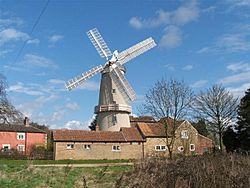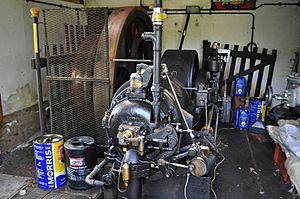Denver Windmill facts for kids
Quick facts for kids Denver Windmill |
|
|---|---|

The restored mill in April 2006.
|
|
| Origin | |
| Mill name | Denver Mill |
| Grid reference | TF 6050 0121 |
| Coordinates | 52°35′06″N 0°22′03″E / 52.5850°N 0.3676°E |
| Operator(s) | Denver Windmill Ltd |
| Year built | 1835 |
| Information | |
| Purpose | Corn mill |
| Type | Tower mill |
| Storeys | Six |
| No. of sails | Four sails |
| Type of sails | Double Patent sails |
| Windshaft | Cast iron |
| Winding | Fantail |
| Fantail blades | Six blades |
| Auxiliary power | Steam engine, later replaced by a diesel engine |
| No. of pairs of millstones | Three pairs |
The Denver Windmill is a historic tower mill in the village of Denver, England. It's a special type of historic building, listed as Grade II*, which means it's considered very important to the nation's history. This windmill has stood for nearly 200 years and has a fascinating story.
Contents
The Story of the Denver Windmill
The windmill you see today was built in 1835 for a man named John Porter. It replaced an even older windmill that stood on the same spot. A special stone on the tower, called a datestone, marks the year it was built.
By 1863, the windmill had a powerful steam engine to help grind grain, even on days without wind. This engine powered three pairs of heavy millstones, and the windmill's sails could also power three pairs.
A Century of Changes
The mill was owned by several people over the years. In 1896, a man named Thomas Harris, who had experience running another windmill, bought it. A powerful storm in 1908 damaged the mill, but it was repaired.
When Thomas Harris passed away in 1925, his son, also named Thomas, took over. He kept the mill running using both wind power and a new diesel engine, which had replaced the old steam engine. In 1937, the younger Thomas Harris received an award for his work in preserving the historic building.
Disaster struck again in 1939 when lightning hit and damaged a sail. Then, in 1941, a part of the mill's cap was damaged, which meant the sails could no longer be used. However, the diesel engine allowed the mill to keep working until 1969.
Saving a Landmark
After 1969, the mill was given to Norfolk County Council to be preserved. Unfortunately, another storm in 1972 blew off a sail, which damaged the windmill's stage (the balcony around the tower). To keep it balanced, the opposite sail was also removed, leaving the mill with only two sails for a while.
Restoration work began in the 1970s to fix the cap, sails, and fantail (the small windmill at the back that turns the cap). However, another gale in 1976 damaged the cap again. It wasn't until the 1990s that major repairs could be made.
In 1995, the Norfolk Historic Buildings Trust bought the mill. A huge project, costing over £1,000,000, was started to bring the windmill back to full working order. The money came from different groups, including the Heritage Lottery Fund. The beautifully restored mill finally opened to the public in March 2000.
A Scary Accident and a Bright Future
On October 4, 2011, a serious accident happened. While the sails were spinning freely in the wind, one of the metal stocks holding them broke. A sail crashed into the one below it, sending pieces flying across the area.
At the time, a group of students from a local primary school was visiting. Some were inside the windmill, and others were eating lunch nearby. The staff at the mill acted quickly, stopping the sails and getting everyone to safety. Thankfully, no one was hurt.
In August 2013, the windmill reopened under new management. The charity that owns the mill is working to raise money to repair and reinstall the sails. Today, the mill complex is open to the public once again.
How the Windmill Works
Denver Windmill is a six-story tower mill. It stands 59 feet (17.98 m) tall. The cap at the top, which holds the sails, has a distinctive curved shape called an "ogee" and is turned into the wind by a fantail.
The mill was designed to use three pairs of large, heavy millstones to grind grain into flour. For extra power, it used a Blackstone diesel engine from 1932. More recently, modern electric mills were added to help with flour production.
People Who Ran the Mill
Many different millers have worked at the Denver Windmill over its long history.
- John Porter 1835-53
- John Gleaves 1853-73
- James Gleaves 1873-96
- Thomas Edward Harris 1896-1925
- Thomas Edwin Harris 1925-69
Visiting the Mill
The Denver Windmill complex is now home to a pub called the Steammill. It is open to the public, so people can visit and see this amazing piece of history up close.
The Mill on TV
The Denver Windmill has appeared on television.
- In 1992, it was a filming location for an episode of the popular British comedy show 'Allo 'Allo!.
- In 2012, the mill and its tea room were featured on the BBC show Alex Polizzi: The Fixer, where a business expert helps family-run businesses improve.


